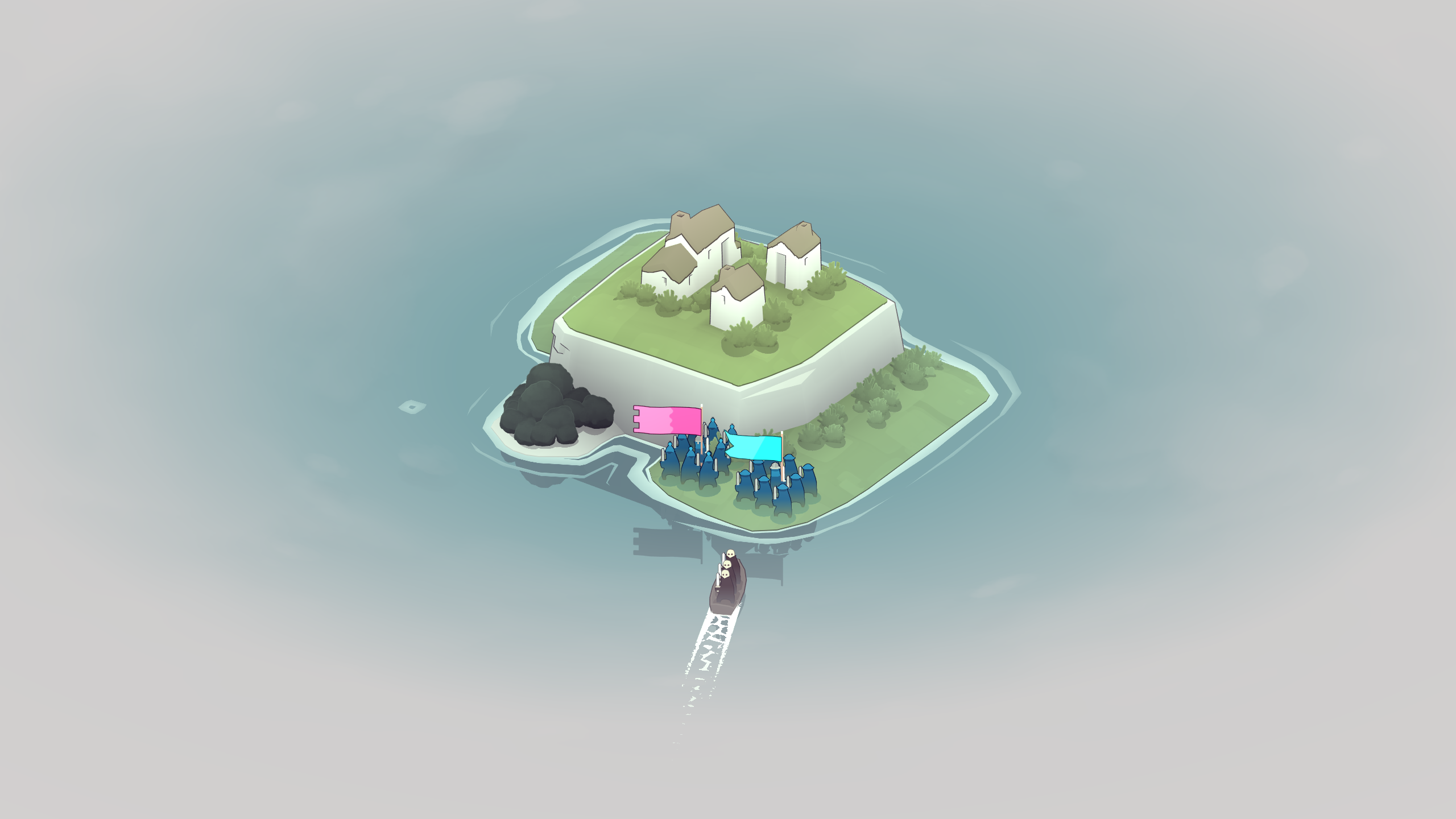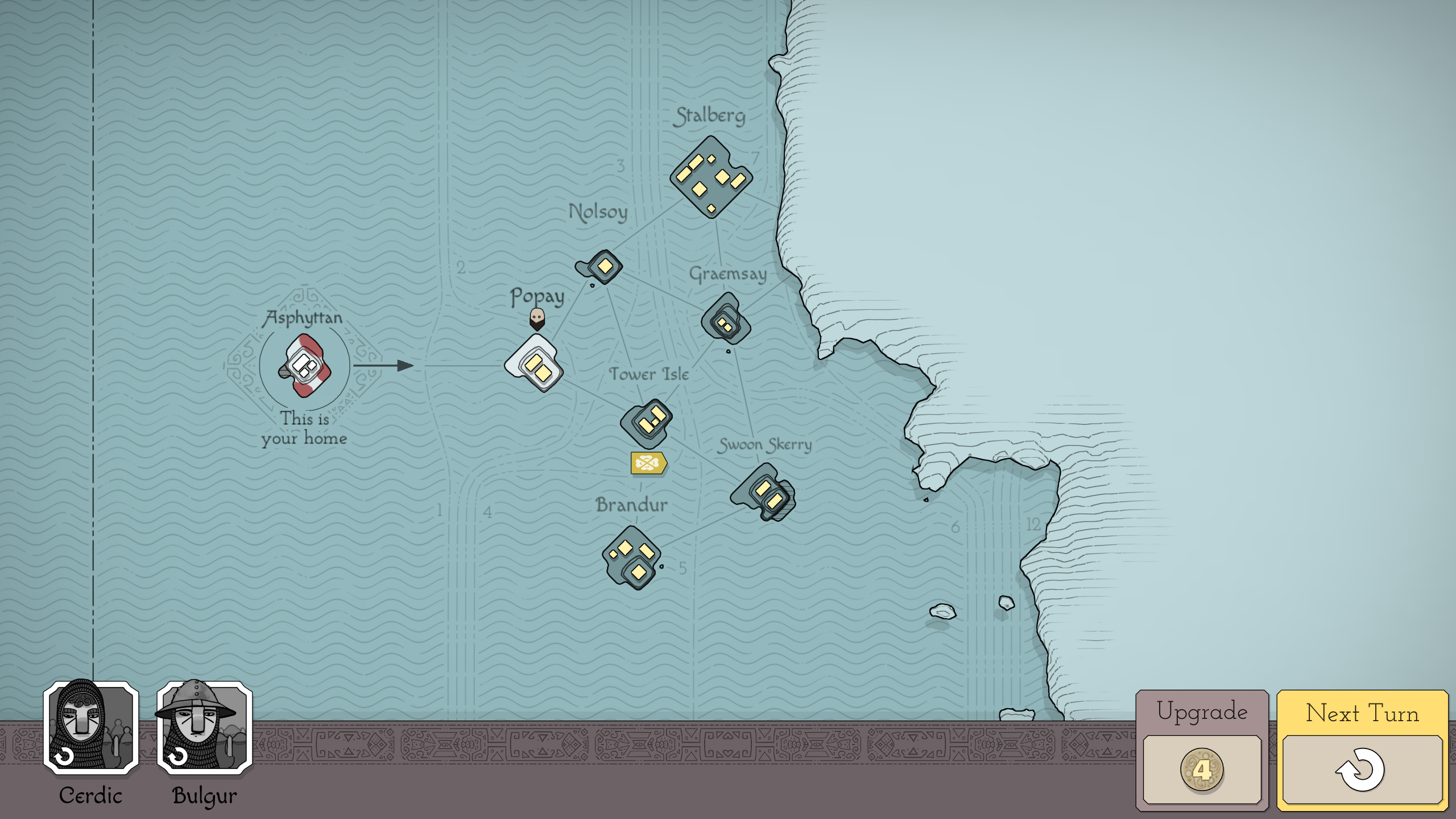As mentioned previously, Epic Games, the creator of Fortnite, is giving away at least one free game a week. In this way I acquired Bad North, the first game by indie developer Plausible Concept. Heralded as a successor to FTL, Bad North follows a tribe fleeing a viking invasion. The player guides his forces from island to island, traveling quickly to stay ahead of the barbarous wave. Generally the story is irrelevant, and the game moves relentlessly from battle to battle.
Each battle happens on a small square island. The player deploys up to four commanders and their forces. A force consists of the commander plus eight soldiers. Most commanders have a passive ability such as additional damage, or quicker movement. Each island is roughly square: a hex grid with flat areas, hills, paths, and buildings. Once the player has deployed their commanders the viking foe arrives in waves. Their seek to slaughter the defenders and burn the buildings, while the player needs to stay alive and protect the people. Any commander who dies in a battle is vanquished permanently, but those that survive carry on to the next battle. Any building that survives awards the player coins to spend on upgrading their commanders. Coins are also spent on commander abilities and upgrading items. Depending on the size of the building, they reward the player with one, two, or three coins.
After the initial battle the player is shown a map. They flee eastward as the vikings chase after them. On most occasions the player chooses between two or three islands to sail to. The map shows each island's terrain, buildings, and enemy types, but doesn't display how many enemies are there, making it impossible to judge a location's difficulty. The map also shows if an island contains a recruitable hero or a magical item. The player can unlock twelve commanders, though they may never assign more than four to a battle. The crucial criteria for picking an island is one the player can beat, but additional heroes and items are a close second. Judging a map requires considering the placement of buildings, but also the terrain. On each island only a portion of the shore is viable for landing. After exiting their boats the enemy advances toward the buildings. Some islands are very defensible, with only one possible path for the enemy to attack. A few are wide open plains with no defensive terrain. But most include a final fall back position to defend the last building.While traveling from island to island, the player discovers an island or two that functions as a check point. Winning a battle at a checkpoint saves the game, and allows the player can revert to position if they suffer a devastating defeat.
Picking the proper island is only the journey, while the destination of combat is the focus of Bad North. The developers created a combat system that favors a back and forth dynamic. Time slows down when the player selects one of their units. Forces move swiftly across the small map, making it possible to defend multiple positions easily. Allied forces engage enemy units even if a space separates them, and they'll pursue, but not too far. The end result is an entertaining flow of battle as soldiers chase and retreat from engagements. When there's a lull in the battle one should order an injured force to retreat into a building. Though they will spend some time out of action, they'll return fully recovered.
One of the charming aspects of Bad North is the aesthetics of battle. The dead leave a bloody residual where they fall, and this stain can even be seen on the map of the islands. Arrows make a delightful plop when they fall in water, or thwack when they hit a shield. Arrows blocked by shields stick, remaining visible, and turning swordsmen into hedgehogs. Across thirty islands the visual effects of the terrain vary wildly. Bad North includes snow covered hills, wooded glens, ancient fortresses, haunted graveyards, glorious waterfalls, dark caverns, and grassy plains. While none of these impact game play, the fearsome visual effect of the Darkness causes the heart of the player to quaver. On at least one island, as the battle continued, the sun began to set. By the time the battle had been won, it was nearly impossible to see.While the player's initial units carry only a short sword, each force can be upgraded into sword and shield men, spearmen, or archers. The player can upgrade each group twice more. Each type of warrior also has an upgradable ability, which can be improved three times. The coins gained in battle by protecting buildings are used for commander upgrade and ability unlocks. Sword and shield men are nearly immune to enemy archers, while spearmen are strongest against enemy infantry, but have minimal protection against ranged attacks. Allied archers only play a supporting role, because they can not harm armored units, and by the end of Bad North that's comprises the majority of the enemy's force.
Combat revolves around a rock, paper, scissors system. The enemy appears in seven different types and each is vulnerable to different allied soldiers. The enemy includes regular swordsmen who die to any commander quite easily. Enemy archers aren't much more dangerous, though they do inflict casualties on spearmen. After these introductory enemies Bad North adds enemy sword and shieldmen, who can't be harmed by allied archers. Tougher enemies follow with armored swordsmen. These enemies are protected from arrows, and defeat swordsmen as well. The sword and axe men are the most frustrating foe for they throw axes before engaging, but also carry shields. They inflict damage against all allied units. The dual wielding swordsmen wreck allied swordsmen, but are weak against archers and spearmen. And finally, the giant armored bowmen shoot arrows which pierce multiple archers and spearmen in a single shot, but are weak to allied swordsmen. The following chart offers a rough estimate of how many of the nine units in a force will die fighting an enemy foe of a particular type. The chart assumes that allied archers have a good defensive position, otherwise they'll lose to anyone.|
Enemy Type ↓ |
Sword and Shield |
Archers |
Spearmen |
|
Soldier |
1 |
2 |
0 |
|
Archer |
0 |
3 |
4 |
|
Sword and Shield |
4 |
9 |
0 |
|
Armored Swordsmen |
5 |
9 |
1 |
|
Axe and Shield |
4 |
9 |
4 |
|
Dual Swords |
6 |
4 |
3 |
|
Armored Bowmen |
1 |
9 |
5 |
The game is full of little details worth learning. Draw enemy archer aggression with shield men, and attack with allied archers. Stand back from enemy landings because boats stun when reaching shore. Elite allied archers can knock even shielded foes off boats and into the water, killing them. And while shield men are nearly invincible to arrows, if they are flanked and facing the wrong direction they'll fall like leaves in autumn.
In Conclusion, Bad North is an interesting game which follows a small clan escaping from vikings. While it has some unique ideas, it is limited by its smallness. The maps are too small. The amount of classes are too small. The number of abilities available are too small. The number of items are too small. And the number of commanders allowed on a battlefield are too small. This smallness limits the tactical variability of battle. It causes the game to become repetitive. Even the brutality of the final battle is limited by the same size of the island, the same number of commanders, and the same enemy types. While it does offer allow some tactical skill with the proper use of terrain, the field so small, that the options are always obvious. Any defeat is the result of having too few commanders, or an overwhelming enemy. On the starting difficulty, I only died in the first run, and completed the second without issue. So while Bad North is a fun little game, there's not enough to keep it afloat for long.
Recent:
Kingdom Come Deliverance: Advancing toward Victory, Royalty, and a SequelRelevant:
Pyre: Into the Flame!Relevant:





Comments
Post a Comment